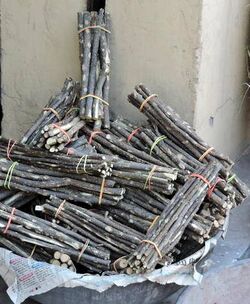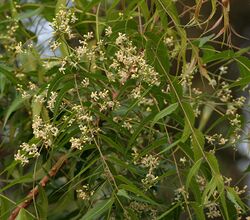Engineering:Teeth cleaning twig
A teeth cleaning twig or datun is a tool made from a twig from a tree. It can help to prevent tooth decay and gum disease.
History
Chew sticks are twigs or roots of certain plants that are chewed until one end is frayed. This end can be used to brush against the teeth,[1] while the other end can be used as a toothpick.[2] Most commonly plants are used that have a high content of tannins (astringent and antibacterial) or other compounds that benefit the health of gums and teeth.[3] The earliest chew sticks have been dated to Babylonia in 3500 BC[2] and an Egyptian tomb from 3000 BC;[1] they are mentioned in Chinese records dating from 1600 BC[2] and in the Tipitaka,[4] the Buddhist Canon, purported to be giving account of events which took place in the north-western India around the 5th century BC.
In Africa, chew sticks are made from the tree Salvadora persica, also known as the "toothbrush tree".
In Islam, this tree is traditionally used to create a chew stick called miswak, as frequently advocated for in the hadith (written traditions relating to the life of Muhammad).[5]
Even today, many Indians in rural areas use neem twigs for brushing every morning. It has antibacterial properties and helps keep gums healthy. It is known to reduce many gum related diseases.
Traditional Sikhs still use datun today as it is written in their scriptures:
ਦਾਤਨ ਕਰੇ ਨਿਤ ਨੀਤ ਨਾ ਦੁਖ ਪਾਵੈ ਲਾਲ ਜੀ ॥ (੨੩)
("Dear/beloved, natural twig brush everyday and pains you shall never get. (23)")
Twigs used

Teeth cleaning twigs can be obtained from a variety of tree species. Although many trees are used in the production of teeth cleaning twigs, some trees are better suited to clean and protect the teeth, due to the chemical composition of the plant parts. The tree species are:[6][7][8][9][10][11]
- Salvadora persica
- Sassafras
- Gumtree[12]
- Lime tree (Citrusaurantafolia)[13]
- Garcinia mannii in West Africa[14]
- Orange tree (Citrus × sinensis)[13]
- African laburnum (Cassia sieberiana)[13]
- Tea tree
- Neem in the Indian subcontinent
- Vachellia nilotica, also called babool or kikar in the Indian subcontinent
- Dalbergia sissoo, also called sheesham in the Indian subcontinent
- Liquorice
- Gouania lupuloides
- Cinnamon
- Dogwood
- Olive
- Walnut
- Acacia catechu
- Acacia nilotica
- and other trees with bitter roots.
United Kingdom, Europe and United States
- Apple
- Pear
- Bamboo
- Fig tree
- Hazelnut
- Oak[3]
- Willow
- Orange
- Lime
- Silver birch
- Olive
- Walnut
- Bay leaf[3]
- Liquorice root
Australia
India
- Peepal tree
- Indian plum or ber fruit tree
- Java plum or jamun tree
- Safed babul
- Apamarga
- Bael tree
- Dhak
- Madar ak
- Kamer
- Karanj
- Vijayasar
- Arjun
- Gular
- Bargad
- Mulhatti
- Tejovati
- Mango
Carrying
Many companies produce special cases for carrying, storing and protecting chew sticks, known popularly as "miswak holders".
Advantages
When compared to toothbrushes, teeth cleaning twigs have several advantages:
- More ecological in its life-cycle
- Lower cost (0–16% of the cost of a toothbrush[12])
- Independence from external supplier if made at home from privately owned trees
- Low maintenance, with some twigs needing moistening with water if they become dry, to ensure the end is soft. The end may be cut afresh to ensure hygiene, and should not be stored near a sink. The twig is replaced every few weeks to maintain proper hygiene.
- No need for toothpaste
On the other hand, different species of trees have various levels of hardness just as synthetic toothbrushes would, so careful selection of the right hardness is required before use. Excessive scrubbing too can also bring the risk of gum damage, though this is a concern for plastic toothbrushes as well.[12]
See also
References
- ↑ 1.0 1.1 Panati, Charles (2013). Extraordinary Origins of Everyday Things. HarperCollins. pp. 208–209. ISBN 978-0-06-227708-4. https://books.google.com/books?id=U662rR2VInQC&pg=PA208.
- ↑ 2.0 2.1 2.2 Yu, Hai-Yang; Qian, Lin-Mao; Zheng, Jing (2013). Dental Biotribology. Springer. pp. 18–19. ISBN 978-1-4614-4550-0. https://books.google.com/books?id=tsSqVeaHUv0C&pg=PA19.
- ↑ 3.0 3.1 3.2 Wolf, PhD, Rowan Walking (2009). Primitive Toothcare: a DIY Guide to Uncivilized Oral Hygiene. Yggdrasil Distro. https://we.riseup.net/assets/287592/primitive+toothcare.pdf.
- ↑ Dantakaṭṭha sutta (AN 5.208) Mahāsaṅgīti Tipiṭaka Buddhavasse 2500
- ↑ "Search Results - miswak (page 1) - Sunnah.com - Sayings and Teachings of Prophet Muhammad (صلى الله عليه و سلم)". sunnah.com. http://sunnah.com/search/miswak.
- ↑ "Neem tree as teeth cleaning twig". Batplants.co.uk. http://www.batplants.co.uk/neemtree.htm. Retrieved 2011-01-17.
- ↑ "Natural twigs used as teeth cleaning twigs". Naturaltoothbrush.com. http://www.naturaltoothbrush.com/. Retrieved 2011-01-17.
- ↑ "Neem tree as teeth cleaning twig 2". Neem-products.com. http://www.neem-products.com/neem-twig.html. Retrieved 2011-01-17.
- ↑ "Natural toothbrush twigs". Naturallygreen.co.uk. 2007-09-15. http://www.naturallygreen.co.uk/natural-toothbrush-twig-natural-p-122.html. Retrieved 2011-01-17.
- ↑ "Natural toothbrush overview". Nzherald.co.nz. 2007-06-19. http://www.nzherald.co.nz/dental-care/news/article.cfm?c_id=1500935&objectid=10446594. Retrieved 2011-01-17.
- ↑ "Xuanzang (玄奘) <603 - 664>: Buddhist records of the Western world (大唐西域記), book VIII/IX.". http://www.payer.de/quellenkunde/quellen122.htm.
- ↑ 12.0 12.1 12.2 Fletcher, Pascal (19 June 2007). "African twig brushes offer all-day dental care". NZME. http://www.nzherald.co.nz/dental-care/news/article.cfm?c_id=1500935&objectid=10446594. Retrieved 17 January 2011.
- ↑ 13.0 13.1 13.2 Ra'ed I. Al Sadhan, Khalid Almas (1999). "Miswak (chewing Stick): A Cultural And Scientific Heritage.". Saudi Dental Journal 11 (2): 80–88.
- ↑ Cheek (2004)




